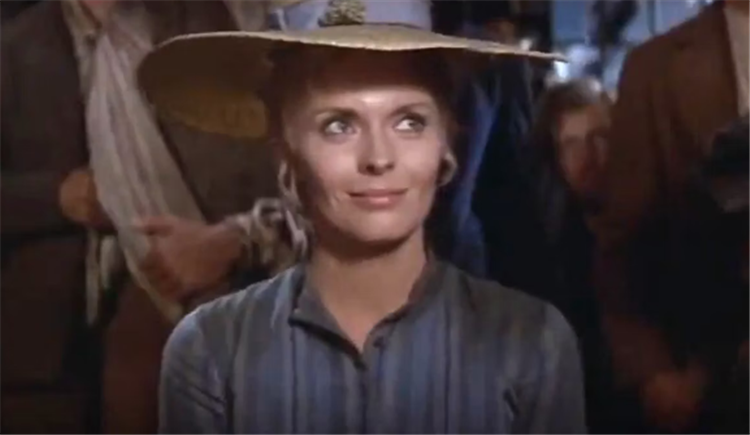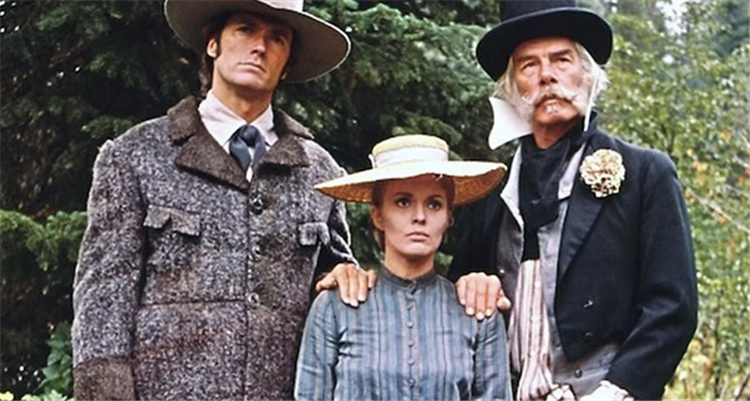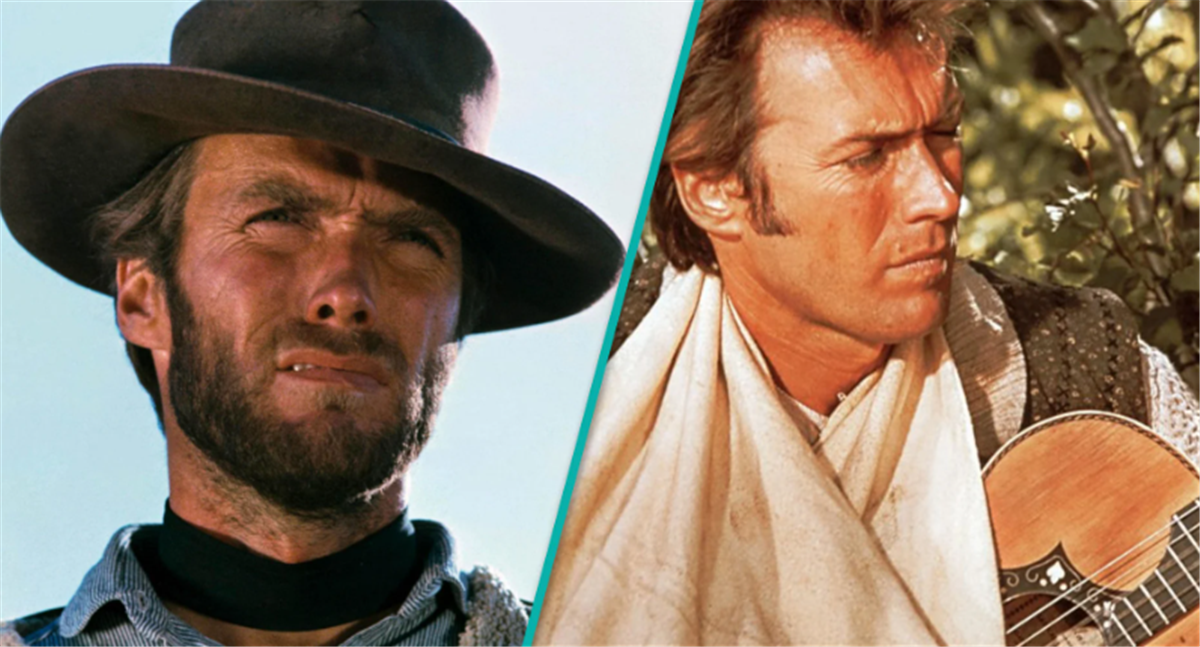If you’ve heard of 1969’s “musical Western” Paint Your Wagon, there’s a decent chance you only know it from The Simpsons. In Season 9, Homer rents Paint Your Wagon for family movie night, hoping for a blood-and-guts western, as the picture stars Lee Marvin and Clint Eastwood, both known as men of violence. The Simpsonized version opens in media res, during what seems to be a tense showdown at high noon. Homer is disappointed when, instead of trying to kill each other, the cowboys break into a song of friendship. (“Gonna paint our wagon! Gonna paint it good!”) It’s very silly. But it’s structurally sound. First it appears to be the prototypical western, then it pivots sharply into a middle-aged cartoon man’s nightmare idea of what a musical is. There’s a purity of form you have to admire. The actual movie Paint Your Wagon, on the other hand, is not like that at all. It’s a baffling mix of conflicting intentions. It’s trying to be a lot of things, and it’s not trying to be any one of those things the most. When you learn about its chaotic production, that explains a little. But you can never really understand a movie like this one.
The Script of ‘Paint Your Wagon’ Embodies A Clash of Styles and Eras
Paint Your Wagon was originally a musical, with book and lyrics by Alan Jay Lerner and music by Frederick Loewe. It opened in 1951 and was not a hit, but the duo of Lerner and Loewe would go on to great success across the 1950s and 1960s, with musicals such as Brigadoon, My Fair Lady, and Camelot. They also crossed over into film with Gigi, 1958’s Best Picture, and the eventual adaptation of My Fair Lady which won Best Picture in 1964. By 1969, Lerner had had a lot of experience with his work becoming filmed, but he had never had much influence over the final project. That was about to change.
The 1960s are often described as the decade that the Hollywood musical died. There’s a parallel with the current decline of comic book movies. Audiences were losing interest, but studios would still spend ruinous amounts of money hoping to have one more hit like The Sound of Music. Lerner was able to convince Paramount Pictures to bankroll a film adaptation of Paint Your Wagon, one of his few remaining unfilmed stage musicals. But it was also not one of his best, and was acknowledged to be a badly outdated 1950s relic.
In order to modernize the story, they brought in Paddy Chayefsky, who would go on to write Network and become a legend, but was then in a career lull between his first and second Oscars. After a brainstorming session with Lerner, Chayefsky, and director Joshua Logan, Chayefsky rewrote the script, keeping very little from the original besides the setting. The updated story still took place during the California Gold Rush, in a sudden boomtown that sprung up overnight after prospector Ben Rumson discovers a motherlode. The 1951 version told a familiar Romeo and Juliet romance between Rumson’s daughter and a Mexican miner. The filmmakers decided to jettison most of those characters, keeping only Rumson. Played by Lee Marvin as a maniacal drunk, he does still kick off the plot by discovering gold. But the two versions of the story diverge immediately. Rumson doesn’t have a daughter. Instead, he’s a loner who becomes business partners with Clint Eastwood’s character, who’s only called “Pardner.” They both fall in love with Elizabeth (Jean Seberg), who comes into town as the second wife in a dysfunctional polygamous Mormon family. Rumson ends up marrying her, but she falls in love with both him and Pardner. At her insistence, the three of them agree to live together in stable polygamy, legal because California is not yet a state. Doesn’t get much more modern than that!
Lerner was disappointed with Chayefsky’s draft of the script, (it didn’t leave enough room for his songs) and fired him. Chayefsky would eventually take his name off the script, and always insisted that the finished product barely contained any of his writing. We don’t know too much about Chayefsky’s draft of Paint Your Wagon, except that it was urbane enough to lure Clint Eastwood onto the picture, important because Charles Bluhdorn, who ran Paramount, was insisting on big stars. But when Eastwood later read Lerner’s rewritten draft, he tried to back out of doing the movie. While the rewrite kept most of Chayefsky’s feisty ideas, it had diluted the story with relentless cornball comedy. Fortunately — or unfortunately, depending on how you look at it — Eastwood was convinced to do the movie despite his reservations.
The Production of ‘Paint Your Wagon’ Was A Slow-Motion Disaster

Joshua Logan had been a theater director before he directed movies. In 1967, he adapted Lerner’s Camelot, which was widely criticized for looking too much like a filmed play. Lerner did not want to make that mistake again. Camelot had been filmed on sound stages. When Lerner brought Logan back for another collaboration, he insisted that Paint Your Wagon be filmed on location. It would turn out to be an expensive decision.
In the story of Paint Your Wagon, Rumson discovers gold during the funeral of Clint Eastwood’s brother. “No-Name City” is the town that blossoms around the gold strike. But, until Elizabeth shows up, the town is entirely male. After Rumson wins the auction to buy Elizabeth off her former husband (it’s okay — it was her idea), he becomes paranoid that the other men of the town are trying to steal her away. So, he arranges for a stagecoach of Parisian sex workers to be diverted to his town, to keep the other men occupied. From here, things snowball, and soon No-Name City is a towering Mecca of vice. The saloons, brothels and casinos of No-Name City were constructed from scratch, in the wilderness of Oregon. “We had jets flying everyone in and out of Oregon, helicopters flying the wives to location for lunch,” said Eastwood, recalling the wild spending. “$20 million down the drain and most of it doesn’t even show on the screen!”
That was the worst part. For all the trouble the production went into building a city in the hills, they got very little out of it that was cinematic. Throughout the shoot, Logan was unhappy with the decision to film on location. Lerner undermined him throughout production, questioning his decisions on set in front of the other crew and attempting to get him replaced. Logan’s filmmaking is pedestrian throughout, as if he was trying to prove how little benefit there was to leaving Los Angeles. He was the wrong man for the job, as is most tragically clear during the film’s bananas third act climax.
After Rumson and Pardner’s claim peters out, they have no income. But they can’t leave town, because their marriage would not be tolerated anywhere else. Rumson’s plan is to build a system of tunnels beneath every saloon in town, to collect the gold dust that drips through the floorboards. This system of mines was actually constructed, and all of No-Name City’s sets were rigged to collapse into the tunnels: a fate meant to recall what befell Sodom and Gomorrah. Nothing quite like this has ever been attempted before or since. But it’s an apathetic apocalypse. It was the last day of a miserable production. “When the last building broke in two, we headed for Los Angeles,” Logan wrote in his book, Movie Stars, Real People, and Me. He never directed another movie.
‘Paint Your Wagon’ Is Too Strange To Be Boring

Paint Your Wagon became emblematic of the bloated zombie musicals of the late 1960s. Studios kept spending more and more money on musicals, paradoxically, because they were losing faith that there was an audience for them. The thing Paint Your Wagon became most famous for was casting of Marvin, Eastwood and Seberg, none of whom can sing. The film gets around this by having most of the singing done in a sad, lonely, whisper. These are men of solitude, and the songs are their quiet despair. That trick can only work so many times, and it doesn’t address the even graver sin, that the movie doesn’t have any dancing. (The Simpsons lied).
There’s something singular about this movie’s attempt to be the musical for people who think they hate musicals. The movie ends up tonally disjointed in every possible way, but amid the chaos there are frequent glimmers of inspiration from the talented people in the cast and crew. It’s easy to invest in the story, and to root for the strange relationship at the center to work out, even if only because it represents something new. And at the end of the day, it’s fun to watch the $20 million be spent. You can’t waste it all. But there’s a more curious appeal. Paint Your Wagon was widely panned by critics of the time, but it was also granted immediate historical importance as the symbolic end of the era of Hollywood musicals. A failed attempt to make musicals appealing to the same audiences who, that same year, would make a $60 million hit out of Easy Rider (which was filmed on a $400,000 budget). And yet, if Lerner, Chayefsky, and company can’t be said to have imagined a future for the musical, perhaps they can at least be credited for imagining a future for the Western.
After all, the plot of Paint Your Wagon echoes strongly in both McCabe and Mrs. Miller and Deadwood, two of the most iconic revisionist Westerns. Like both of those, it re-imagines the archetypical western not as a clash between sheriffs and outlaws on a dusty street, but as the progression of commerce into new territories. The protagonist of this story is not a gunslinger, but an entrepreneur who figures out how to siphon money off of a quasi-urban mining town. And the villain is the force of amalgamated capital that follows him to the frontier, to steal through violence what he has built, and eventually to suck the town dry.
Paint Your Wagon doesn’t have the clarity of vision that those other two masterworks have. But that loopy incoherence also frees it to imagine a ridiculous alternate history, where instead of corporate mining interests, the town is bled to death by its own drunken and degenerate founders, through a system of secret tunnels. Pauline Kael, in her on-the-money review, saw in these tunnels a metaphor for the studio system’s hollowing out of the musical genre. A lot of her review seems relevant today: she asks of the studios, “if they have so few new ideas that they’ve got to hoard the old ones and try to mold them into new shapes, are they still artists?” We seem to be living through the end of something. But maybe in the future some movie lovers will be able to pick through our most degraded multiversal superhero movies and failed franchise reboots, and detect the earliest glimmers of whatever ends up coming next.
